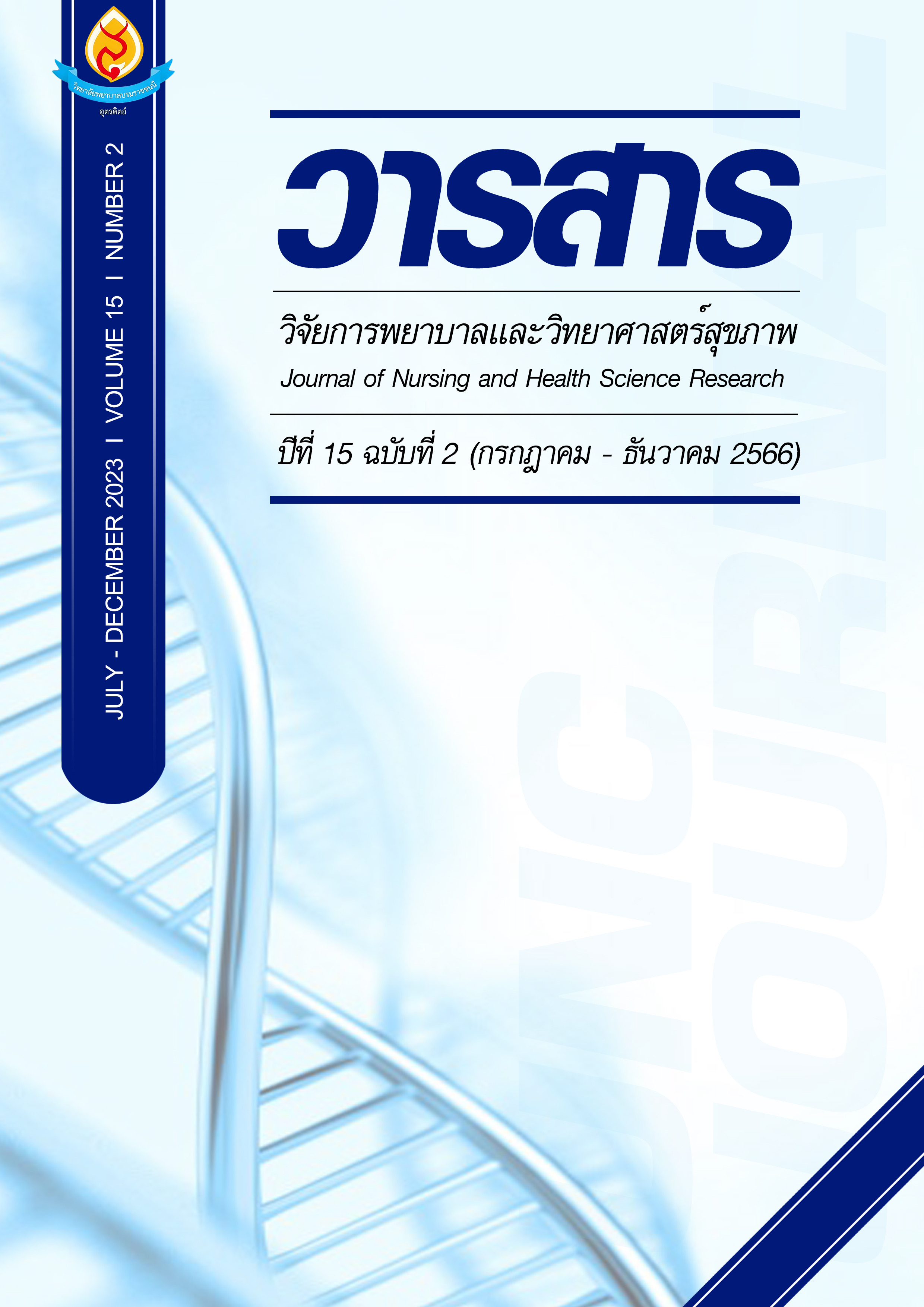การพัฒนาแบบวัดความงอกงามทางใจหลังเผชิญเหตุการณ์วิกฤติในเด็กยากไร้
Main Article Content
บทคัดย่อ
การวิจัยนี้มีวัตถุประสงค์เพื่อพัฒนาและตรวจสอบคุณภาพของแบบวัดความงอกงามทางใจหลังเผชิญเหตุการณ์วิกฤติในเด็กยากไร้ กลุ่มตัวอย่างเป็นเด็กยากไร้ในโรงเรียนศึกษาสงเคราะห์แห่งหนึ่งในภาคใต้ 200 ราย เครื่องมือที่ใช้ในการวิจัยคือ แบบวัดความงอกงามทางใจหลังเผชิญเหตุการณ์วิกฤติ สถิติที่ใช้ในการวิเคราะห์ข้อมูล ได้แก่ การวิเคราะห์ค่าความเชื่อมั่นและความเที่ยงตรงของแบบวัด และการวิเคราะห์องค์ประกอบเชิงยืนยัน (Confirmatory Factor Analysis: CFA) ผลการวิจัยพบว่าแบบวัดความงอกงามทางใจหลังเผชิญเหตุการณ์วิกฤติที่ผ่านการตรวจสอบความเที่ยงตรงเชิงเนื้อหาจากผู้เชี่ยวชาญ 3 ท่าน มีค่าดัชนีความสอดคล้องระหว่างข้อคำถามกับนิยามปฏิบัติการอยู่ระหว่าง .66 – 1.00 มีค่าอำนาจจำแนกรายข้อจากการพิจารณาค่าสัมประสิทธิ์สหสัมพันธ์ระหว่างคะแนนรายข้อกับคะแนนรวมระหว่าง .35 – .70 มีค่าความเชื่อมั่นเท่ากับ .87 และมีความเที่ยงตรงเชิงโครงสร้างโดยพิจารณาจากความเที่ยงตรงแบบลู่เข้า และการวิเคราะห์องค์ประกอบเชิงยืนยัน พบว่าโมเดลการวัดมีความสอดคล้องกลมกลืนกับข้อมูลเชิงประจักษ์ (= 113.85, df = 118, p-value = .59, GFI = .94, AGFI = .91, CFI = 1.00, SRMR = .04, RMSEA = .00, CN = 265.78) แบบวัดประกอบด้วย 5 องค์ประกอบ มีข้อคำถามทั้งหมด 19 ข้อ ดังนั้นแบบวัดที่พัฒนาขึ้นมีความเหมาะสม มีความน่าเชื่อถือและสอดคล้องกับทฤษฎีที่เกี่ยวข้อง สามารถนำไปใช้เป็นตัวบ่งชี้ในการประเมินความงอกงามทางใจหลังเผชิญเหตุการณ์วิกฤติของเด็กยากไร้หลังเผชิญเหตุการณ์วิกฤติได้ต่อไป
Article Details

อนุญาตภายใต้เงื่อนไข Creative Commons Attribution-NonCommercial-NoDerivatives 4.0 International License.
บทความหรือข้อคิดเห็นใดใดที่ปรากฏในวารสารวิจัยการพยาบาลและวิทยาศาสตร์สุขภาพ เป็นวรรณกรรมของผู้เขียน ซึ่งบรรณาธิการหรือสมาคมศิษย์เก่า ไม่จำเป็นต้องเห็นด้วย และบทความที่ได้รับการตีพิมพ์เผยแพร่ถือเป็นลิขสิทธิ์ของวารสารวิจัยการพยาบาลและวิทยาศาสตร์สุขภาพ
เอกสารอ้างอิง
Bagozzi, R. P., Yi, Y., & Phillips, L. W. (1991). Assessing construct validity in organizational research. Administrative Science Quarterly, 36(3), 421-458.
Bassellier, G., Benbasat, I. & Reich, B. H. (2003). The influence of business manager’ ITcompetence on championing IT. Information System Research, 14(4), 317-336.
Bywaters, P., Bunting, L., Davidson, G., Hanratty, J., Mason, W., McCarten, C. & Steils, N. (2016). The relationship between poverty, child abuse and neglect: an evidence review. Retrieved from https://www.researchgate.net/publication/295812966
Chin, W. W. (1998). The partial least squares approach for structural equation modeling. In G. A. Marcoulides (Ed.). Modern methods for business research. London: Lawrence Erlbaum Associates.
Duangurai, A. (2015). Psychological experiences of posttraumatic growth in veterans. (Master’s thesis). Chulalongkorn University. (in Thai).
Farrell, C. A., Fleegler, E. W., Monuteaux, M. C., Wilson, C. R., Christian, C. W. & Lee, L. K. (2017). Community poverty and child abuse fatalities in the United States. Pediatrics, 139(5), 1-9.
Freedy, J. R. & Hobfoll, S. E. (2013). Traumatic stress: from theory to practice. New York: Springer.
Fornell, C. & Larcker, D. F. (1981). Evaluating structural models with unobservable variables and measurement error. Journal of Marketing Research, 18, 39-50.
Hair, J.F., Black, W.C., Babin, B.J. & Anderson, R.E. (2010). Multivariate Data Analysis. (7th ed.). Pearson: New York.
Hacney. (2014). Child poverty needs assessment 2014. Retrieved from
Hijazi, A. M., Lumley, M. A., Ziadni, M. S., Haddad, L., Rapport, L. J. & Arnetz, B. B. (2014). Brief narrative exposure therapy for posttraumatic stress in Iraqi refugees: a preliminary randomized clinical trial. Journal of Traumatic Stress, 27(3), 314-322.
Jirek, S. L. (2017). Narrative reconstruction and post-traumatic growth among trauma survivors: The importance of narrative in social work research and practice. Qualitative Social Work, 16(2), 166-188.
Kanchanawasi, S. (2009). Classical test theory (6th ed.). Bangkok: Faculty of Education, Chulalongkorn University. (in Thai).
Kilmer, R. P., Gil-Rivas, V., Tedeschi, R. G., Cann, A., Calhoun, L. G., Buchanan, T. & Taku, K. (2009). Use of the revised posttraumatic growth inventory for children. Journal of Trauma Stress, 22(3), 248-253.
Kilmer, R. P., Gil-Rivas, V., Griese, B., Hardy, S. J., Hafstad, G. S. & Alisic, E. (2014). Posttraumatic growth in children and youth: clinical implications of an emerging research literature. American Journal of Orthopsychiatry, 84(5), 506-518.
Laceulle, O. M., Kleber, R. J. & Alisic, E. (2015). Children's experience of posttraumatic growth: distinguishing general from domain-specific correlates. PLoS ONE, 10(12), 1-12.
Louis, K. (2018). Posttraumatic growth in children and their parents following child sexual abuse. (Phd’s thesis). The State University of New Jersey, New Jersey.
Ministry of social development and human security Thailand. (2017). Family and domestic violence situation report for section 17 of domestic violence victim protection act year 2017. Bangkok: Ministry of Social Development and Human Security Thailand. (in Thai).
Minujin, A., Delamonica, E., Davidziuk, A. & Gonzalez, E. D. (2006). The definition of child poverty: a discussion of concepts and measurements. Environment & Urbanization, 18(2), 481-500.
Prapaithong, T. (2015). Effect of personal growth group with photo-elicitation on posttraumatic growth and psychological well-being among women with post breast cancer treatment. (Master’s thesis). Chulalongkorn University. (in Thai).
Roth, D. H. (2004). Adult reflections on childhood verbal abuse. (Phd’s thesis). University of Saskatchewan.
Sleijpen, M., Haagen, J., Mooren, T. & Kleber, R. (2016). Growing from experience: an exploratory study of posttraumatic growth in adolescent refugees. European Journal of Psychotraumatology, 7, 1-10.
Srichaisawat, C. (2017). Relationships among personality, working alliance, and posttraumatic growth among individuals with counseling service experiences. (Master’s thesis). Chulalongkorn University. (in Thai).
Steffens, R. F. & Andrykowski, M. A. (2015). Posttraumatic growth inventory: overview. Retrieved from https://link.springer.com/referenceworkentry/10.1007%2F978-3-319-08613-2_12-1
Tedeschi, R. G., & Calhoun, L. G. (2004). Posttraumatic growth: conceptual foundations and empirical evidence. Psychological Inquiry, 15(1), 1-18.
Williston, S. K. (2017). Experiencing trauma can eventually result in positive personal changes.
Retrieved from https://www.anxiety.org/what-is-post-traumatic-growthptg
Wiratchai, N. (1999). Lisrel model: statistical analysis for research (3rd ed.). Bangkok: Chulalongkorn University Printing. (in Thai).


